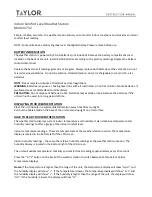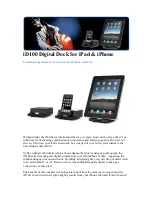
B. FOLDOUT TABLE STAND:
The foldout table stand leg is located on the backside.
1) Pull the stand out from the bottom center edge of the
weather station, below the battery compartment.
2) Once the foldout table stand is extended, place the
weather station in an appropriate location.
TROUBLESHOOTING
NOTE:
For problems not solved, please contact La Crosse Technology.
Problem:
No reception of WWVB time signal.
Solution:
1) Wait overnight for signal.
2) Be sure indoor weather station is at least 6 feet from any electrical devices, such as televisions,
computers, or other radio-controlled clocks.
3) Remove batteries for five minutes, reinsert and leave the unit alone overnight without pressing
buttons.
4) If there are still problems, contact La Crosse Technology.
Problem:
Hour is incorrect (minute and date are correct).
Solution:
Be sure correct time zone and daylight saving time settings are selected.
Problem:
The LCD is faint.
Solution:
1) Set the LCD contrast to a higher number.
2) Replace the batteries
Problem:
No outdoor temperature is displayed.
Solution:
1) Remove all batteries, reinsert into remote temperature sensor first, then the indoor weather station.
2) Place the remote temperature sensor closer to the display.
3) Be sure all batteries are fresh.
4) Place the remote temperature sensor and indoor weather station in position so the straight-line signal
is not passing through more than two or three walls.
Problem:
Temperatures do not match if units are placed next to each other.
Solution:
Each temperature sensor is manufactured to be accurate to within 2 degree plus or minus and under
normal conditions, so two sensors could be as much as 4 degrees different. However, the difference can
be exaggerated further because the sensors are designed for different working environments. The
indoor temperature sensor is less responsive to ambient air currents because of the shielding effect of
the display's case. In addition, the case can act as a heat sink to absorb and store heat from external
sources (i.e. handling of the case or radiant heat). Also, the much greater range of the remote
temperature/humidity sensor requires a different calibration curve than the indoor range. Error is
usually greater at the extreme ends of a range, making it harder to compare different ranges with
different curves. Under non-
16




































